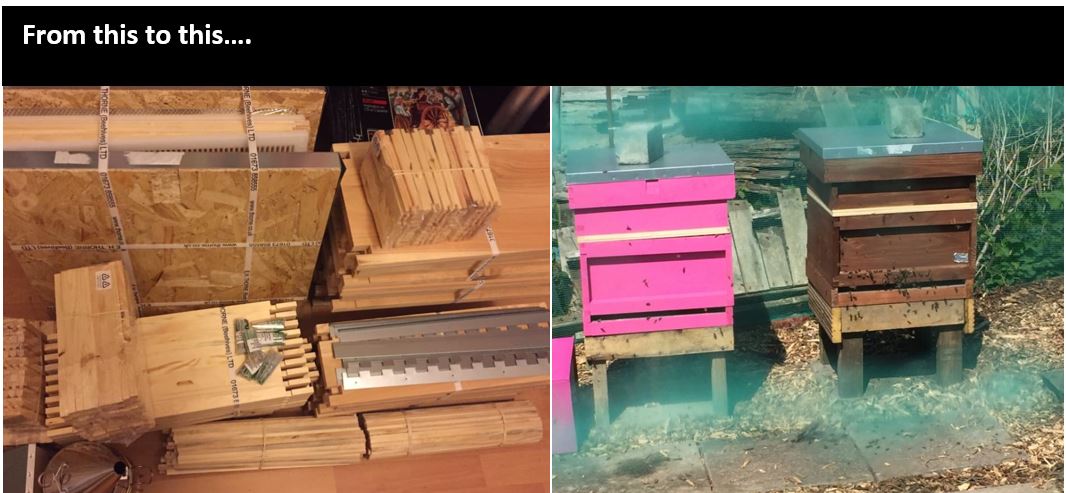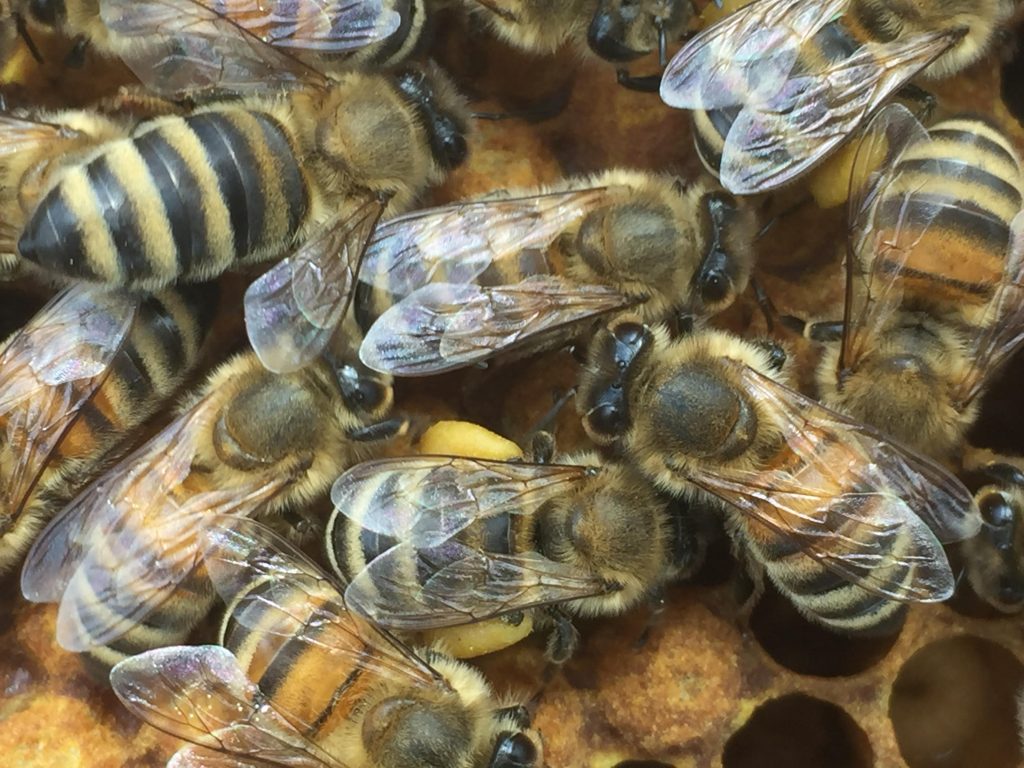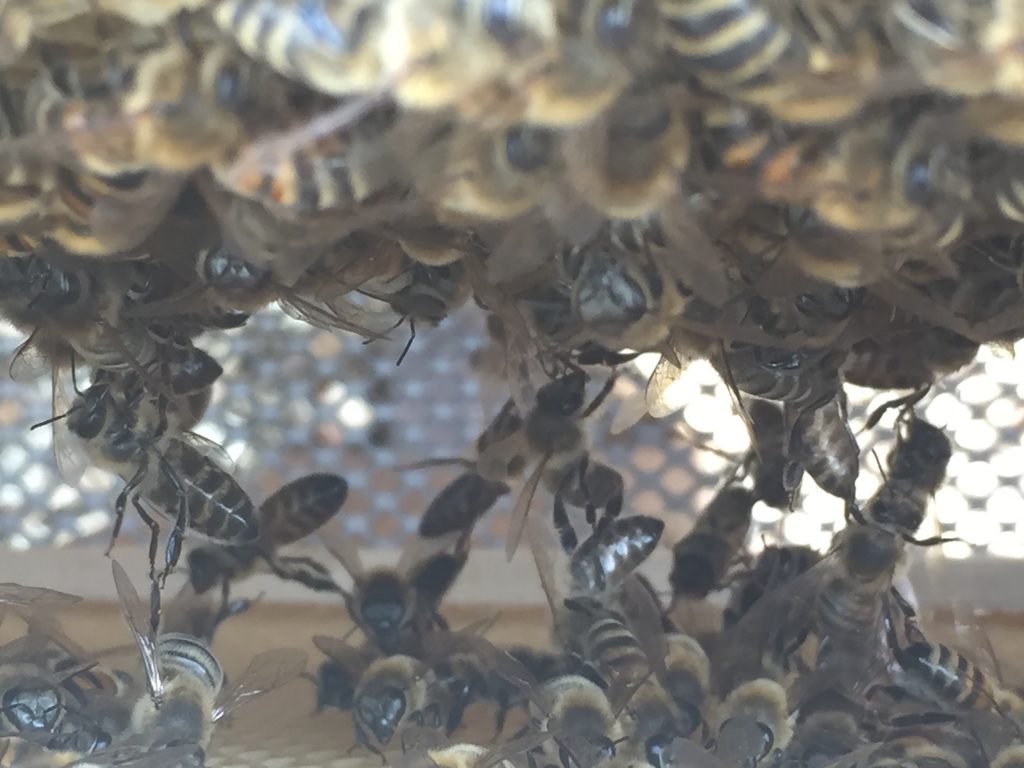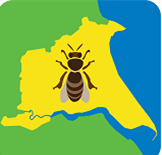lessons learned in the first month of beekeeping

When it comes to preparing for an inspection, I still haven’t mastered the art of getting suited and booted (good to see the BBKA assessment doesn’t include this!) When Patrick arrives he’s ready in seconds. I’m trying to extract my legs from the arms of the suit, still bootless and minus veil, when he’s striding up the path ready to go. As for putting on a double layer of nitrile gloves, there must be a secret method but I haven’t discovered it yet.
At least I’ve improved my inspection routine. This includes lighting the smoker (never stays lit first time but always does on the second) and moving everything I might need into the apiary area. To start with, my box of bits was so heavy I could hardly lift it. I’ve learned the essentials are hive tool, smoker, camera.
Routines include where to stand and where to put the roof, feeder, crown board and supers as you take them off. It helps to put the roof upside-down near your feet, but not where you can trip over it, then stack everything on top. It might sound basic but when you’re a newbie, not doing this can lead to trouble. You really don’t want to stumble and take a hive of bees with you!

It’s then a question of reading what you see. How do the bees look and sound? Are they bringing in pollen? Are they quiet or getting agitated? What are they telling you?
Separating frames involves more skill than I first realised, especially when they’re stuck together. You need to split gently to minimise tearing comb, avoid jerking the brood box (bees don’t like being knocked) and keep a space on either side when lifting so the bees don’t get rolled or squished.

It’s good to keep the frame over the box in case the queen drops off. It hasn’t happened to me yet but I’ve heard enough stories to be convinced of the risk!
Examining both sides for progress and potential problems can be demonstrated but the real learning comes from doing it yourself. It’s one thing to light a smoker on an apiary open day, or hold someone else’s frame, but something else entirely to be standing on your own, looking into an open hive and thinking help, what do I do now.
Pollen was exciting; I hadn’t realised it came in so many different colours or pollen charts existed for identification. Nectar and sugar syrup both sparkle in the sun. The bees had frames of new foundation to draw, so I was feeding syrup to provide extra energy for making wax. Honey in the cells had a white capping while the tops over larvae was biscuit coloured and shh…. not sure if anyone else feels the same way but larvae freak me out a bit, they’re very alien.

I learned eggs are laid standing on their end, vertically, before falling over to lie horizontally by the third day, and soon I was repeating gestation times like a mantra. Beats counting sheep to get to sleep! Queen larvae is capped at 8 days and emerges at 16, Workers are capped at 9 days and emerge at 21, while Drones get capped at 10 days and emerge at 24 (approximately, like all things in beekeeping, nothing is too precise).
Worker bees have multiple roles. They are cleaners, nurses, wax makers, ventilators, guards, foragers, and collectors of the dead. The six week life of a worker bee in the summer produces one single teaspoon of honey, a queen can lay over 1000 eggs a day and there’s over 65,000 cells in a British Standard National (BSN) Brood Box. Phew…

Beekeeping is amazing. How can anyone not be fascinated by a colony of honey bees? Even more when you consider most of their work inside is done in the dark. I want glass hives (or tinted windows at least) so I can sit and watch them all day.
In the first month, I watched two colonies develop, introduced fellow plotters, family and friends to the inside of a hive, and had my first sting. I’ve learned beekeeping isn’t a hobby it’s a lifestyle, and if I had to pick out key lessons, it would be these.
- painting your hive boxes pink, and then trying to disguise the apiary area, is incompatible,
- bees have been doing it for themselves for millenia so they will teach you, it’s a two-way relationship, and they never ever read the books,
- all colonies are different, having two hives as a minimum lets you compare and learn even more,
- all beekeepers are different so don’t match yourself to others in terms of progress (note to self),
- keeping detailed records at the start, rather than relying on memory, is essential, and it helps to look at these before an inspection (another note to self),
- bees can progress very quickly, on the fourth week I was delighted at the extent the brown hive girls had expanded; the biggest lesson of all was this didn’t ring warning bells or raise any red flags!
More about my first swarm experience in the next post…


